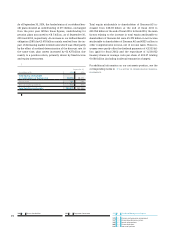Siemens 2014 Annual Report Download - page 222
Download and view the complete annual report
Please find page 222 of the 2014 Siemens annual report below. You can navigate through the pages in the report by either clicking on the pages listed below, or by using the keyword search tool below to find specific information within the annual report.
108 A. To our Shareholders 131 B. Corporate Governance 171 C. Combined Management Report
172 C. Business and economic environment
187 C. Financial performance system
193 C. Results of operations
205 C. Financial position
210 C. Net assets position
through an increase in productivity. Taking together all ele-
ments of the Environmental Portfolio that were installed at cus-
tomer locations since the beginning of fiscal and remain
in use today, we have reduced customer carbon dioxide emis-
sions by million metric tons in fiscal , which is the
equivalent of the following thirteen cities’ combined yearly
emissions: Berlin, Bogotá, Cape Town, Hong Kong, London, Los
Angeles, Melbourne, Mexico City, Moscow, New York City, São
Paulo, Seoul and Tokyo.
C... SELECTION CRITERIA
An Environmental Portfolio element can be a product, a system,
a solution or a service. Furthermore, a core component of a
system or solution may qualify as an Environmental Portfolio
element if the component provided by Siemens is key to en-
abling environmental benefits resulting from the system’s or
solution’s overall application. To qualify for inclusion in the
Environmental Portfolio, an element must meet one of the se-
lection criteria described below, which are energy efficiency,
renewable energy or environmental technologies. Products,
systems, solutions and services with planned application in
military use or nuclear power are not included in the Environ-
mental Portfolio.
>
Energy efficiency: The criteria for energy efficiency are an
improvement in energy efficiency of % or more during the
customer use phase compared to the applicable baseline, or
a reduction of at least , metric tons of carbon dioxide
equivalents per reporting period in the customer use phase.
Examples of elements that meet the energy efficiency crite-
rion are combined cycle power plants and intelligent build
-
ing technology systems.
>
Renewable energy: This criterion covers technologies in the
field of renewable energy sources such as wind turbines or
smart grid applications and their respective core compo-
nents.
>
Environmental technologies: This criterion is related to wa-
ter and wastewater treatment, air pollution control, waste
reduction, recycling, e-car infrastructure and its core compo-
nents. It also includes the Siemens Consulting Service which
analyzes customers’ environmental impact. Additionally, a
criterion for the Healthcare Sector is an environmental
impact reduction in terms of noise, radiation or total weight
of at least % compared to the baseline.
C... GOVERNANCE AND REPORTING APPROACH
The qualification of Environmental Portfolio elements as well
as their respective reporting is based on defined processes and
criteria. The business portfolio of Siemens’ continuing opera-
tions is reviewed annually regarding the qualification of Envi-
ronmental Portfolio elements based on the criteria described
before. This covers the inclusion of newly developed elements
as well as the integration of additionally qualified elements
where evidence of fulfillment of the qualification criteria was
not available in prior reporting periods. For additionally quali-
fied Environmental Portfolio elements, we report their pri-
or-year revenue and prior-year contribution to reducing cus-
tomer carbon dioxide emissions on a comparable basis.
Elements that no longer fulfill our qualification criteria are ex-
cluded from our Environmental Portfolio.
We report the revenue from our Environmental Portfolio and
annual customer reductions of carbon dioxide emissions gener-
ated by it in accordance with internal regulations defined in our
Environmental Portfolio Guideline. This Guideline is based on
the Reporting Principles of the Greenhouse Gas Protocol Corpo-
rate Accounting and Reporting Standard, revised edition, and
the Greenhouse Gas Protocol for Project Accounting. The rev-
enue generated by the Environmental Portfolio is recognized in
accordance with revenue recognition policies as described in
NOTE in D. NOTES TO CONSOLIDATED FINANCIAL STATEMENTS.
C.. Environmental protection
Indicators
Year ended September ,
Energy efficiency improvement
compared to baseline in fiscal 11% 5%
Waste efficiency improvement
compared to baseline in fiscal 12% 8%
Waste for disposal reduction
compared to baseline in fiscal 8% 10%
Carbon dioxide emission efficiency
improvement compared to baseline
in fiscal 20% 14%
1 Continuing operations.
2 Indicator incorporates weighted calculations related to the primary fuels
consumed in generating the energy used at our sites and the amount of energy
used to extract, convert and distribute the fuels consumed.
To meet today’s global ecological challenges responsibly,
Siemens has a comprehensive EHS (Environmental Protection,
Health Management and Safety) management system. The pro-
cess requirements of this management system help our operat-
ing units comply with applicable laws, regulations and customer
requirements, satisfy our corporate requirements properly and
achieve our Siemens-wide environmental targets. The environ-
mental protection management system requires that our rele-
vant production and office sites must implement an environ-
mental management system which fulfills the requirements of
the internationally recognized ISO standard and also our
own internal standard, known as “Specifications on environ-
mentally compatible product and system design.” This internal
























